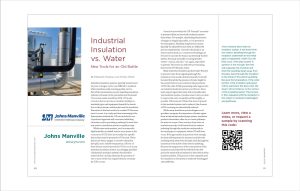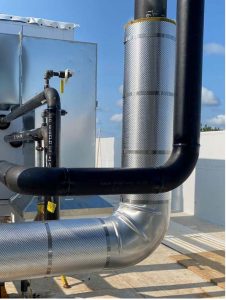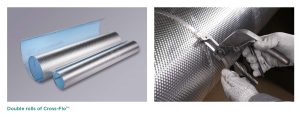Johns Manville- Industrial Insulation vs. Water
New Tools for an Old Battle
Johns Manville
www.jm.com
Industrial insulation systems, typically meant to last 20 years or longer, can be very difficult to maintain while simultaneously ensuring quality service. Part of the maintenance process regarding insulation systems is focused on the prevention and treatment of corrosion under insulation (CUI). CUI is any corrosion that occurs due to moisture buildup on insulated pipes and equipment beneath the insulation or the protective metal jacket over the insulation. Prevention is the best method to combat CUI because once it occurs, it is costly and time consuming to fix. Preventative methods for CUI can include the use of products ingrained with corrosion-inhibiting chemistry and/or providing a pathway for water that may enter an insulation system to rapidly escape.
While some environments, such as areas with high humidity or rainfall, may be more prone to the occurrence of CUI, there are actually four specific factors that must be present for CUI to start. These factors are water, oxygen, a corrosive chemistry (low pH), and a suitable temperature. All four of these factors must be present for CUI to occur in any industrial insulation system. Accordingly, specifiers of industrial insulation systems should utilize materials that can help eliminate the presence of one or more of the four required factors necessary for CUI to occur.
Certain factors within the CUI “formula” are easier to prevent within an industrial insulation system than others. For example, eliminating the presence of oxygen is simply impossible, as it is present in the atmosphere. Similarly, temperatures cannot typically be adjusted because they are defined by process requirements. Corrosive chemicals in an indoor system (such as a commercial building) can be easier to account for than in an externally located system, but many naturally occurring weather events—such as acid rain—are, again, impossible to prevent. This leaves us with the last remaining factor in the CUI formula: water.
Many industrial insulation products have features to prevent water from migrating through the insulation to the metal substrate beneath. It should be noted that while the presence of water might be the easiest factor we can control in the prevention of CUI, the odds of fully preventing water ingress into an industrial insulation system are still zero. Since most experts agree that water will eventually enter any insulation system, it makes sense to focus on how to remove the water as quickly and thoroughly as possible. If the amount of time that water is present in the insulated system can be reduced, the chances of CUI occurring are dramatically reduced.
Once moisture does enter an insulation system, it will travel from the exterior jacketing through the insulation underneath to the metal pipe or equipment, where CUI will then occur. If the pipe system in question is hot enough, the heat will evaporate the moisture and drive the resulting steam away from the pipe, back through the insulation to the inside of the exterior jacketing. Because the temperature of the outer portion of the insulation and jacket will be well below the dew point, the steam will recondense on the surface of the insulation/jacket. This process is then repeated until the insulation in the system is rendered waterlogged and inefficient.
Learn more, view a video, or request a sample by scanning this code:
While many insulation system designers and specifiers recognize the importance of water egress from an industrial insulated pipe system, insulation products themselves often do not create pathways for water to escape. Once moisture does enter an insulation system, it will travel from the exterior jacketing through the insulation underneath to the metal pipe or equipment, where CUI will then occur. If the pipe system in question is hot enough, the heat will evaporate the moisture and drive the resulting steam away from the pipe, back through the insulation to the inside of the exterior jacketing. Because the temperature of the outer portion of the insulation and jacket will be well below the dew point, the steam will recondense on the surface of the insulation/jacket. This process is then repeated until the insulation in the system is rendered waterlogged and inefficient.
To help combat this issue, Johns Manville (JM) recently introduced a new metal jacketing product, Cross-Flo™, designed specifically to help mitigate the occurrence of CUI in industrial insulation systems. When used in conjunction with weep holes positioned at the low points of the system, Cross-Flo’s patent-pending embossed design creates a pathway for water to quickly flow between the jacketing and insulation to exit through the weep holes. As compared to typical stucco embossed and smooth metal jacketing like that offered by JM, Cross-Flo’s pattern allows water to exit the system quickly and completely, and the Cross-Flo pattern allows water to effectively drain in any orientation (horizontal, vertical, etc.). This is not the case for cross-crimped jacketing, another metal jacketing option offered by JM, which is only effective at aiding in water egress when installed vertically. When installed horizontally, water will instead pool in the cross-crimped jacketing patterning, trapping more water between the jacketing and insulation beneath it.
The best CUI prevention strategy should take advantage of all the tools available to help reduce the risk for it to occur. In addition to using Cross-Flo metal jacketing in industrial insulated pipe systems, further steps can be taken to address the possibility of CUI. Many pipe insulations are now produced with corrosion-inhibiting chemistry, which acts as a secondary mitigation method if water does penetrate past metal jacketing in a system. When exposed to the water that entered the system, this chemistry works by neutralizing the corrosive (acidic) level of water and forming a protective silica passivation layer on the surface of the metal, thereby slowing down the rate at which the metal in the system corrodes. When specifying insulation with corrosion-inhibiting chemistry in combination with metal jacketing such as Cross-Flo, designers and specifiers can provide multiple levels of protection against CUI. This, in turn, should significantly reduce the high costs of repairing/replacing corroded pipes and equipment, and prevent unplanned downtime. Together, these practices can help extend the integrity and lifespan of an industrial pipe insulation system.




